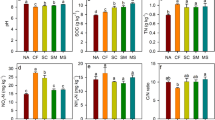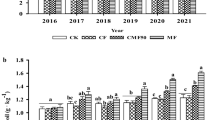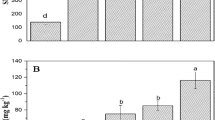Abstract
Purpose
The stability of soil organic matter is a key predictor of changes in management practices due to the progressive decomposition of organic compounds. However, the dynamics of soil compounds and to what extent the composition of microbes controls the process are still unclear.
Methods
Black soils from Northeast China without fertilizer (CK), soil treated with chemical fertilizer (NPK), NPK plus maize straw (NPKS), and NPK plus cattle manure (NPKM) were collected and separated into the labile fraction (macroaggregates > 150 μm) and the recalcitrant fraction (microaggregates < 150 μm and mineral fraction > 150 μm) for a 14-day incubation.
Results
The net carbon (C) and net nitrogen (N) mineralization potentials of the labile fraction were 15.87–26.11 and 0.74–1.48 mg kg−1 soil day−1, respectively, which were between 1.4 and 2.3 times higher than those of the recalcitrant fraction. Compared with CK, NPKS and NPKM significantly increased C and N mineralization in the labile fraction but not in the recalcitrant fraction. Boosting regression tree analysis suggested that total nitrogen (TN), microbial biomass nitrogen (MBN), and bacterial abundance accounted for 48.9%, 31.7%, and 14.0% of the total net C mineralization, respectively. Additionally, soil organic carbon (SOC), microbial biomass carbon (MBC), and bacterial abundance accounted for 39.4%, 37.3%, and 22.1% of the total net N mineralization, respectively. Path analysis showed that TN, MBN, and Brevundimonas positively influenced soil net C mineralization. SOC and MBC positively affected soil net N mineralization, whereas unclassified Comamonadaceae had a negative impact.
Conclusions
The mineralization of soil C and N was affected by the inputs of external inorganic nutrients and organic materials and was attributed to the bacterial community, in which Brevundimonas positively responded and contributed to mineralization, while unclassified Comamonadaceae responded negatively.




Similar content being viewed by others
References
Ahmad W, Singh B, Dijkstra FA, Dalal RC (2013) Inorganic and organic carbon dynamics in a limed acid soil are mediated by plants. Soil Biol Biochem 57:549–555
Akinsete SJ, Nortcliff S (2014) Storage of total and labile soil carbon fractions under different land-use types: a laboratory incubation study. Soil Carbon. In: Hartemink AE, McSweeney K (eds) Progress in Soil Science. Springer International Publishing, Switzerland, pp 197–207
Bayhan Gİ, Tanır G, Karaman İ, Özkan Ş (2013) Comamonas testosteroni: an unusual bacteria associated with acute appendicitis. Balkan Med J 30:447
Bimüller C, Kreyling O, Kölbl A, Lützow MV, Knabner IK (2016) Carbon and nitrogen mineralization in hierarchically structured aggregates of different size. Soil Tillage Res 160:23–33
Bom F, Nunes I, Raymond NS, Hansen V, Bonnichsen L, Magid J, Nybroe O, Jensen LS (2018) Long-term fertilisation form, level and duration affect the diversity, structure and functioning of soil microbial communities in the field. Soil Biol Biochem 122:91–103
Bremner JM, Mulvaney CS (1982) Nitrogen-total. In: Page LA, Milley RH, Keeney DR (eds) Methods of Soil Analysis. American Society of Agronomy, Madison, pp 595–642
Bruhn ST, Bloem J, Vries FT, Kalbitz K, Wagg C (2012) Linking soil biodiversity and agricultural soil management. Curr Opin Environ Sustain 4:523–528
Buczolits S, Rosengarten R, Hirt R, Busse HJ (2001) Classification of a Brevundimonas strain detectable after PCR with a Helicobacter-specific primer pair. Syst Appl Microbiol 24:368–376
Cui J, Zhu Z, Xu X, Liu S, Ge T (2020) Carbon and nitrogen recycling from microbial necromass to cope with C:N stoichiometric imbalance by priming. Soil Biol Biochem 142:Article 107720
Ding J, Jiang X, Ma M, Zhou B, Li J (2016) Effect of 35 years inorganic fertilizer and manure amendment on structure of bacterial and archaeal communities in black soil of northeast China. Appl Soil Ecol 105:187–195
Doltra J, Gallejones P, Olesen JE, Hansen S, Frøseth RB, Krauss M, Stalenga J, Jończyk K, Martínez FA, Pacini CC (2019) Simulating soil fertility management effects on crop yield and soil nitrogen dynamics in field trials under organic farming in Europe. F Crop Res 233:1–11
Edgar RC (2010) Search and clustering orders of magnitude faster than BLAST. Bioinformatics 26:2460–2461
Fang YY, Nazaries L, Singh BK, Singh BP (2018) Microbial mechanisms of carbon priming effects revealed during the interaction of crop residue and nutrient inputs in contrasting soils. Glob Chang Biol 24:2775–2790
Fang Y, Singh BP, Collins D, Armstrong R, Zwieten LV, Tavakkoli E (2020) Nutrient stoichiometry and labile carbon content of organic amendments control microbial biomass and carbon-use efficiency in a poorly structured sodic–subsoil. Biol Fertil Soils 56:219–233
Fierer N, Bradford MA, Jackson RA (2007) Toward an ecological classification of soil bacteria. Ecology 88:1354–1364
Frasier I, Quiroga A, Noellemeyer E (2016) Effect of different cover crops on C and N cycling in sorghum NT systems. Sci Total Environ 562:628–639
Ge H, Batstone DJ, Keller J (2015) Biological phosphorus removal from abattoir waste-water at very short sludge ages mediated by novel PAO clade Comamonadaceae. Water Res 69:173–182
Giannetta B, Plaza C, Vischetti C, Cotrufo MF, Zaccone C (2018) Distribution and thermal stability of physically and chemically protected organic matter fractions in soils across different ecosystems. Biol Fertil Soils 54:671–681
Guo J, Liu X, Zhang Y, Shen J, Han W, Zhang W, Christie P, Goulding KWT, Vitousek PM, Zhang F (2010) Significant acidification in major Chinese croplands. Science 327:1008–1010
Huang W, Hall SJ (2017) Elevated moisture stimulates carbon loss from mineral soils by releasing protected organic matter. Nat Commun 8:1–8
Huygens D, Rütting T, Boeckxa PO, Cleemputa V, Godoyc R, Müller C (2007) Soil nitrogen conservation mechanisms in a pristine south Chilean Nothofagus forest ecosystem. Soil Biol Biochem 39:2448–2458
Jiang YJ, Liang YT, Li CM, Wang F, Sui YY, Suvannang N, Zhou JZ, Sun B (2016) Crop rotations alter bacterial and fungal diversity in paddy soils across East Asia. Soil Biol Biochem 95:250–261
Kamaa M, Mburu H, Blanchart E, Chibole L, Chotte JL, Kibunja C, Lesueur D (2011) Effects of organic and inorganic fertilization on soil bacterial and fungal microbial diversity in the Kabete long-term trial, Kenya. Biol Fertil Soils 47:315–321
Kästner M (2000) “Humification” process or formation of refractory soil organic matter. In: Rehm HJ, Reed G (eds) Environmental processes II, vol 11b. Biotechnology, 2nd edn. Wiley-VCH, Weinheim, pp 89–125
Konno N, Habu N, Maeda I, Azuma N, Isogai A (2006) Cellouronate (β-1,4-linked polyglucuronate) lyase from Brevundimonas sp. SH203: Purification and characterization. Carbohydr Polym 64:589–596
Kumar M, Kundu DK, Ghorai AK, Mitra S, Singh SR (2018) Carbon and nitrogen mineralization kinetics as influenced by diversified cropping systems and residue incorporation in Inceptisols of eastern Indo-Gangetic Plain. Soil Tillage Res 178:108–117
Kuzyakov Y, Friedel JK, Stahr K (2000) Review of mechanisms and quantification of priming effects. Soil Biol Biochem 32:1485–1498
Li J, Wen Y, Li X, Li Y, Zhao B (2018) Soil labile organic carbon fractions and soil organic carbon stocks as affected by long-term organic and mineral fertilization regimes in the North China Plain. Soil Tillage Res 175:281–290
Liu C, Zhou L (2017) Soil organic carbon sequestration and fertility response to newly-built terraces with organic manure and mineral fertilizer in a semi-arid environment. Soil Tillage Res 172:39–47
Mandal A, Patra AK, Singh D, Swarup A, Masto ER (2007) Effect of long-term application of manure and fertilizer on biological and biochemical activities in soil during crop development stages. Bioresour Technol 98:3585–3592
Meijboom FW, Hassink J, Noordwijk VM (1995) Density fractionation of soil macroorganic matter using silica suspensions. Soil Biol Biochem 27:1109–1111
Mikha MM, Rice CW (2004) Tillage and manure effects on soil and aggregate-associated carbon and nitrogen. Soil Sci Soc Am J 68:809–816
Mohanty S, Nayak AK, Kumar A, Tripathi R, Shahid M, Bhattacharyya P, Raja R, Panda BB (2013) Carbon and nitrogen mineralization kinetics in soil of rice-rice system under long term application of chemical fertilizers and farmyard manure. Eur J Soil Biol 58:113–121
Mooshammer M, Wanek W, Hämmerle I, Fuchslueger L, Hofhansl F, Knoltsch A, Schnecker J, Takriti M, Watzka M, Wild B, Keiblinger KM, Boltenstern SZ, Richter A (2014) Adjustment of microbial nitrogen use efficiency to carbon: nitrogen imbalances regulates soil nitrogen cycling. Nat Commun 5:3694
Nelson DW, Sommers LE (1996) Total carbon, organic carbon, and organic matter. In: Methods of Soil Analysis. American Society of Agronomy, USA, pp 961–1010
Okano K, Hristova KR, Leutenegger CM (2004) Application of real-time PCR to study effects of ammonium on population size of ammonia-oxidizing bacteria in soil. Appl Environ Microbiol 70:1008–1016
Puget P, Chenu C, Balesdent J (1995) Total and young organic matter distribution in aggregates of silty cultivated soils. Eur J Soil Sci 46:449–459
Puget P, Chenu C, Balesdent J (2000) Dynamics of soil organic matter associated with particle-size fractions of water-stable aggregates. Eur J Soil Sci 51:595–605
Qin Z, Huang Y, Zhuang Q (2013) Soil organic carbon sequestration potential of cropland in China. Glob Biogeochem Cycles 27:711–722
Quast C, Pruesse E, Yilmaz P, Gerken J, Schweer T, Yarza P, Peplies J, Glöckner FO (2013) The SILVA ribosomal RNA gene database project: improved data processing and web-based tools. Nucleic Acids Res 1:590–596
Sarma B, Borkotoki B, Narzari R, Kataki R, Gogoi N (2017) Organic amendments: effect on carbon mineralization and crop productivity in acidic soil. J Clean Prod 152:157–166
Sarma B, Farooq B, Gogoi N, Borkotoki B, Kataki R, Garg A (2018) Soil organic carbon dynamics in wheat-Green gram crop rotation amended with vermicompost and biochar in combination with inorganic fertilizers: A comparative study. J Clean Prod 201:471–480
Schmidt MWI, Torn MS, Abiven S, Dittmar T, Guggenberger G, Janssens IA, Kleber M, Knabner IK, Lehmann J, Manning DAC, Nannipieri P, Rasse DP, Weiner S, Trumbore SE (2011) Persistence of soil organic matter as an ecosystem property. Nature 478:49–56
Six J, Conant RT, Paul EA, Paustian K (2002) Stabilization mechanisms of soil organic matter: implications for C-saturation of soils. Plant Soil 241:155–176
Steinweg JM, Fisk MC, McAlexander B, Groffman PM, Hardy JP (2008) Experimental snowpack reduction alters organic matter and net N mineralization potential of soil macroaggregates in a northern hardwood forest. Biol Fertil Soils 45:1–10
Suzuki K, Matsunaga R, Hayashi K, Matsumoto N, Okada K (2014) Effects of traditional soil management practices on the nutrient status in Sahelian sandy soils of Niger, West Africa. Geoderma 223–225:1–8
Tan ZX, Lal R, Owens L, Lzaurralde RC (2007) Distribution of light and heavy soil organic carbon as related to land use and tillage practice. Soil Tillage Res 92:53–59
Tian J, Pausch J, Yu G, Blagodatskaya E, Gao Y, Kuzyakov Y (2015) Aggregate size and their disruption affect 14C-labeled glucose mineralization and priming effect. Appl Soil Ecol 90:1–10
Treseder KK (2008) Nitrogen additions and microbial biomass: a meta-analysis of ecosystem studies. Ecol Lett 11:1111–1120
Vance E, Brookes PC, Jenkinson DS (1987) An extraction method for measuring soil microbial biomass C. Soil Biol Biochem 19:703–707
Wang Q, Garrity GM, Tiedje JM, Cole JR (2007) Naive Bayesian classifier for rapid assignment of rRNA sequences into the new bacterial taxonomy. Appl Environ Microbiol 73:5261–5267
Wang W, Sardans J, Zeng C, Zhong C, Penuelas J (2014) Responses of soil nutrient concentrations and stoichiometry to different human land uses in a subtropical tidal wetland. Geoderma 232:459–470
Willems A (2014) The family Comamonadaceae. The Prokaryotes: Alphaproteobacteria and Betaproteobacteria: 777–851
Yamashita T, Flessa H, John B, Helfrich M, Ludwig B (2006) Organic matter in density fractions of water–stable aggregates in silty soils: Effect of land use. Soil Biol Biochem 38:3222–3234
Yin C, Fan F, Song A, Cui P, Li T, Liang Y (2015) Denitrification potential under different fertilization regimes is closely coupled with changes in the denitrifying community in a black soil. Appl Microbiol Biotechnol 99:5719–5729
Yin Y, Gu J, Wang X, Zhang Y, Zheng W, Chen R (2019) Effects of rhamnolipid and Tween-80 on cellulase activities and metabolic functions of the bacterial community during chicken manure composting. Bioresour Technol 288:121507
Yu H, Ding W, Luo J, Geng R, Ghani A, Cai Z (2012) Effects of long-term compost and fertilizer application on stability of aggregate-associated organic carbon in an intensively cultivated sandy loam soil. Biol Fertil Soils 48:325–336
Zhang W, Parker KM, Luo Y, Wan S, Wallace LL, Hu S (2005) Soil microbial responses to experimental warming and clipping in a tallgrass prairie. Glob Chang Biol 11:266–277
Zhou ZC, Gan ZT, Shangguan ZP, Zhang FP (2013) Effects of long-term repeated mineral and organic fertilizer applications on soil organic carbon and total nitrogen in a semi-arid cropland. Eur J Agron 45:20–26
Acknowledgments
We thank colleagues at the long-term experiment station (Gongzhuling, Jilin, China) for providing us with the soil samples.
Funding
This work was financially supported by the Agro-scientific Research in the Public Interest of China (201503122) and the Agricultural Science and Technology Innovation Program of Chinese Academy of Agricultural Sciences (CAAS-XTCX2016008).
Author information
Authors and Affiliations
Corresponding author
Ethics declarations
Conflict of interest
The authors declare that they have no conflict of interest.
Additional information
Responsible editor: Weixin Ding
Publisher’s note
Springer Nature remains neutral with regard to jurisdictional claims in published maps and institutional affiliations.
Supplementary Information
ESM 1
(DOCX 273 kb)
Rights and permissions
About this article
Cite this article
Wu, H., Cai, A., Xing, T. et al. Fertilization enhances mineralization of soil carbon and nitrogen pools by regulating the bacterial community and biomass. J Soils Sediments 21, 1633–1643 (2021). https://doi.org/10.1007/s11368-020-02865-z
Received:
Accepted:
Published:
Issue Date:
DOI: https://doi.org/10.1007/s11368-020-02865-z




